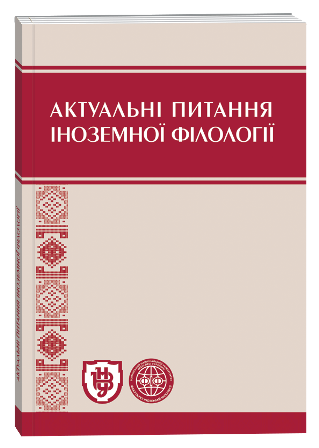EUPHEMISMS AS THE MEANS OF VERBALIZING THE LINGUOCULTURAL CONCEPT «DEATH» IN THE NOVEL «ME BEFORE YOU» BY JOJO MOYES
Keywords:
linguoculture, euphemism, euphemistic constructions, lexico-semantic language system, concept «death», lexemeAbstract
The article deals with the peculiarities of the functioning of euphemisms in modern English. The causes of the emergence and historical development of the phenomenon of euphemism have been investigated. The basic ways of formation of euphemisms have been studied and their role in the lexico-semantic system of modern English has been analyzed. The valeur of euphemisms in the domain of linguocultural studies has been determined. Specific examples of the use of euphemistic constructions used to verbalize the linguocultural concept of «death» in the novel «Me before you» written by a contemporary British writer Jojo Moyes are given. On the research material, the role of euphemisms as contextual synonyms of direct nominations in the fiction has been analyzed, and the features of author’s euphemistic constructions in the novel «Me before you» have been studied. The cases in which Jojo Moyes uses euphemistic constructions to verbalize the concept «death» have been investigated. The list of lexemes, which the writer uses in the euphemistic constructions under investigation, is represenred. The theme of death in the novel «Me before you» by Jojo Moyes, the features of the linguocultural concept under study and the background of the problem of deliberately ending a person’s life by assisted suicide are analyzed. The use of euphemisms allows our speech to be multifaceted, and contributes to a better coverage of a controversial topic. Incorrect representation of the thematic features may lead to certain conflicts in the socio-historical, linguocultural background. That is why euphemism is a convenient way of verbalizing contradictory, somewhat unpleasant concepts, such as «death» and «euthanasia» in literature. The prospects of further conceptual analysis of works of fiction with to study the role of euphemisms in the process of verbalizing different linguistic and cultural concepts are determined.
References
Артюшкина Л. В. Семантический аспект эвфемистической лексики в современном английском языке : дис. … канд. филол. наук / Л. В. Артюшкина. – М., 2001. – 135 с.
Арутюнова Н. Д. Мова і світ людини / Н. Д. Арутюнова. – 2-е вид., испр. – М. : Мови російської культури, 1999. – I – XV, 896 с.
Вежбицкая А. Мова. Культура. Пізнання / А. Вежбицкая. – М., 1997. – 416 с.
Воркачев С. Г. Лінгвокультурології, мовна особистість, концепт: становлення антропоцентричної парадигми в мовознавстві / С. Г. Воркачев // Філологічні науки. – 2001. –№ 1. – С. 64–72.
Єлізарова Г. В. Культурологічна лінгвістика: досвід дослідження поняття у методичних цілях / Г. В. Єлізарова. – СПб : Вид-во Бельведер, 2000. – C. 39–70.
Карасик В. І. Лінгвокультурний концепт як одиниця дослідження / В. І. Карасик, Г. Г. Слишкін / Методологічні проблеми когнітивної лінгвістики : наукове видання / за ред. І. А. Стерніна. – Воронезький державний університет, 2001. – C. 75–79.
Кацев А. М. Эвфемизмы в современном английском языке: опыт социолингвистического описания / А. М. Кацев : дис. … канд. филол. наук. – Л., 1977. – 190 с.
Ларин Б. А. История русского языка и общее языкознание. – М., 1977. – С. 189–199.
Левицкий В. В. Экспериментальные методы в семасиологии / В. В. Левицкий, И. А. Стернин. – Воронеж : Изд-во Вор. ун-та, 1989. – 192 с.
Словник української мови : в 11 томах. – Том 2. – 1971. – 453 с.
Телія В. М. Російська фразеологія. Семантичні, прагматичні та лінгвокультурологічні аспекти / В. М. Телія. – М. : Школа «Мови російської культури», 1996. – 288 с.
Якобсон Р. Лінгвістика і поетика / Структуралізм: «за» і «проти». – М., 1975. – С. 193–230.
Holder R. W. How Not To Say What You Mean: A Dictionary of Euphemisms / R. W. Holder. – Oxford-New-York : Oxford University Press, 2002. – 525 p.
Moyes J. Me before you / Moyes Jojo., 2012. – 321 с.
Warren B. What euphemisms tell us about the interpretation of words // Studia Linguistica, 1992. – Vol. 46/2. – P. 128–172.
Downloads
Published
How to Cite
Issue
Section
License
Copyright (c) 2025 Леся Малімон, Діана Лепка

This work is licensed under a Creative Commons Attribution 4.0 International License.







